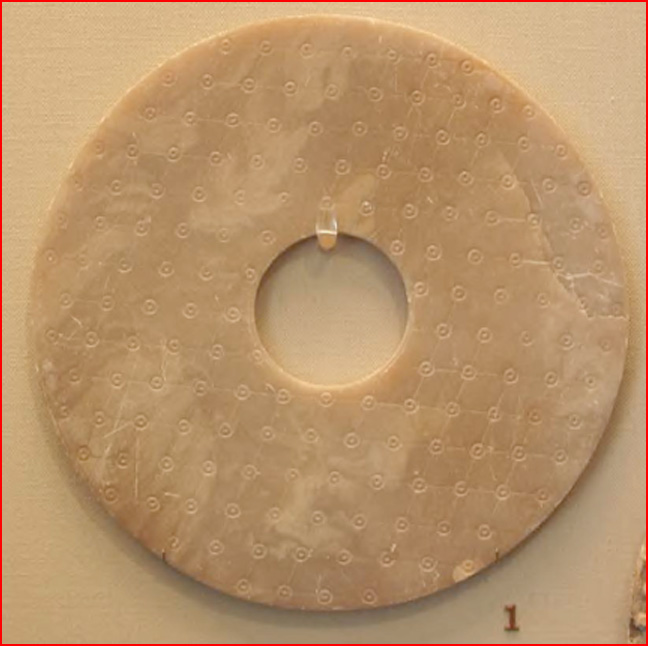
Chinese jade disc symbolizing the sky. Credit: Rens Van der Sluijs
Shown here is a so-called bi disc, a Chinese jade disc with a hole in the middle. Such discs, often with a ‘pockmarked’ surface identified as a ‘rice grain’ pattern, have been produced in China at least from the Neolithic period (±2500 BCE) onwards, particularly in the region of Shanghai in southeast China. Certainly during the Zhōu and Hàn dynasties (12th century BCE to 3rd century CE), they symbolized the sky or the cosmos.
Chinese cosmology prominently features the region of the pole star as the center of the cosmos. Yet, surely the Chinese did not envision a gaping hole at the celestial pole? The idea of a hole in the fabric of the circumpolar sky may not have been attested directly in Chinese sources, but abundant traditions from many other parts of the world, such as the Chukchi in northeastern Siberia, postulate precisely that.
The Old Turks used to call the pole star ‘a smoke hole of the sky’. Communities throughout North America subscribed to a belief in “the hole of the sky”, which at least the Lakota and the Blackfoot people specify as being situated “in the northern circumpolar star world”. Gods and goddesses, legendary ancestors and heroes, and the souls of shamans alike are often imagined to use the cosmic hole as a gateway between worlds, a ‘door’ or ‘window’ without which there is no way denizens of the sky can travel to earth and vice versa.
Stargazers may have a hard time trying to figure out just what aspect of the heavenly north pole could have prompted the popular folkloristic image of an opening in the sky. A crucial pointer is the repeated association of the hole with the axis mundi or ‘world axis’: the tip of the tree, mountain, pillar, ladder or rope that ties the regions of the universe together passes through the hole in the sky, and not infrequently the column itself is presented as a hollow object, too.
The Maya people of Yucatán, for example, describe “seven celestial planes, each with a central hole through which the cosmic Ceiba tree extends its branches ….” The sky hole emerges as a property of the complex morphology of the axis mundi.
Intensive collaboration between plasma physicists, electrical engineers and comparative mythologists has recently led to the hypothesis that the mythology of the world axis is convincingly explained as a high-energy auroral z-pinch that formed on the boundary between the Paleolithic and the Neolithic periods, at a time of profound geomagnetic instability.
At times of intense electric flux, this auroral column could have appeared to human eyes as a colossal hollow tube. Visible particles traveling through this tube could have been conceived as animated mythical entities voyaging between the extremities of the cosmos. In this light, the perplexing notion of a hole in an otherwise solid firmament gains plausibility and strikes one for its accuracy in the face of ‘common sense’ observation of the heavens today.
Contributed by Rens Van der Sluijs
Source: http://thunderbolts.info
Sem comentários:
Enviar um comentário